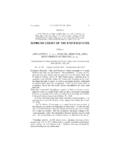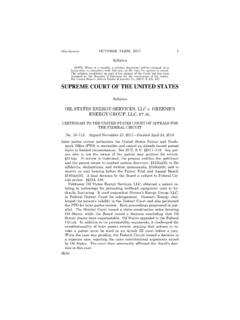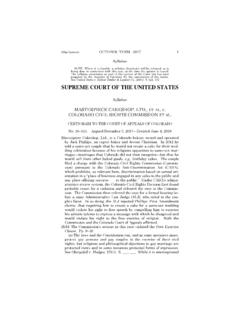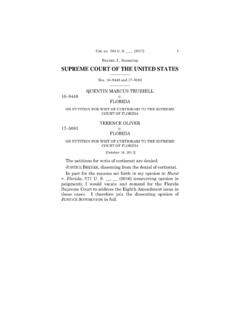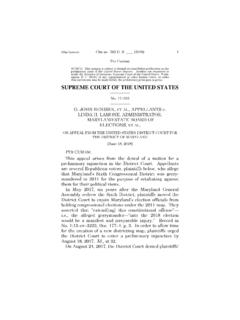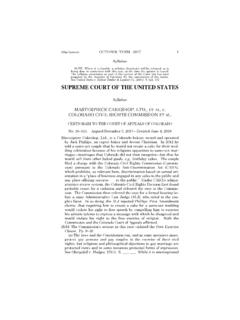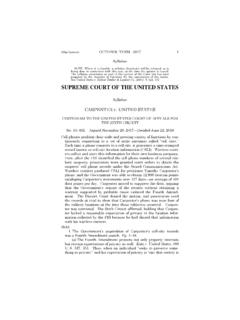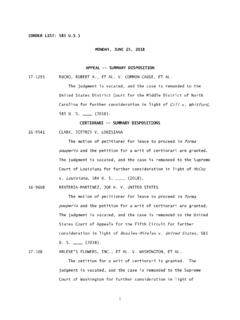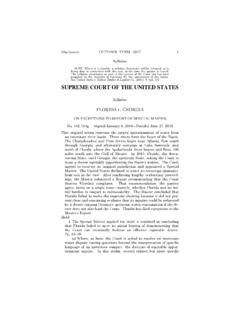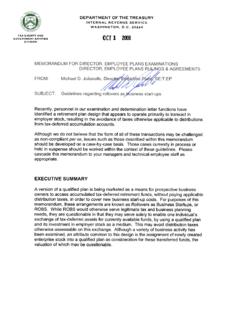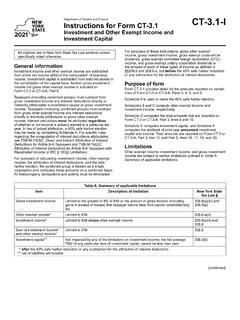Transcription of SUPREME COURT OF THE UNITED STATES
1 1 (Slip Opinion) OCTOBER TERM, 2020 Syllabus NOTE: Where it is feasible, a syllabus (headnote) will be released, as is being done in connection with this case, at the time the opinion is issued. The syllabus constitutes no part of the opinion of the COURT but has been prepared by the Reporter of Decisions for the convenience of the reader. See UNITED STATES v. Detroit Timber & Lumber Co., 200 U. S. 321, 337. SUPREME COURT OF THE UNITED STATES Syllabus CALIFORNIA ET AL.
2 V. TEXAS ET AL. CERTIORARI TO THE UNITED STATES COURT OF APPEALS FOR THE FIFTH CIRCUIT No. 19 840. Argued November 10, 2020 Decided June 17, 2021* The Patient Protection and Affordable Care Act as enacted in 2010 re-quired most Americans to obtain minimum essential health insurancecoverage and imposed a monetary penalty upon most individuals who failed to do so. Amendments to the Act in 2017 effectively nullified the penalty by setting its amount to $0. Subsequently, Texas (along with over a dozen STATES and two individuals) brought suit against federalofficials, claiming that without the penalty the Act s minimum essen-tial coverage provision, codified at 26 U.
3 S. C. 5000A(a), is unconsti-tutional. They sought a declaration that the provision is unconstitu-tional, a finding that the rest of the Act is not severable from 5000A(a), and an injunction against enforcement of the rest of the Act. The District COURT determined that the individual plaintiffs had standing. It also found 5000A(a) both unconstitutional and not sev-erable from the rest of the Act. The Fifth Circuit agreed as to the ex-istence of standing and the unconstitutionality of 5000A(a), but con-cluded that the District COURT s severability analysis providedinsufficient justification to strike down the entire Act.
4 Petitioner Cal-ifornia and other STATES intervened to defend the Act s constitutional-ity and to seek further review. Held: Plaintiffs do not have standing to challenge 5000A(a) s minimumessential coverage provision because they have not shown a past or future injury fairly traceable to defendants conduct enforcing the spe-cific statutory provision they attack as unconstitutional. Pp. 4 16.(a) The Constitution gives federal courts the power to adjudicate * Together with No. 19 1019, Texas et al. v. California et al., also on certiorari to the same COURT .
5 2 CALIFORNIA v. TEXAS Syllabus only genuine Cases and Controversies. Art. III, 2. To have stand-ing, a plaintiff must allege personal injury fairly traceable to the de-fendant s allegedly unlawful conduct and likely to be redressed by therequested relief. DaimlerChrysler Corp. v. Cuno, 547 U. S. 332, 342. No plaintiff has shown such an injury fairly traceable to the alleg-edly unlawful conduct challenged here. Pp. 4 5.(b) The two individual plaintiffs claim a particularized individual harm in the form of past and future payments necessary to carry the minimum essential coverage that 5000A(a) requires.
6 Assuming thispocketbook injury satisfies the injury element of Article III standing,it is not fairly traceable to any allegedly unlawful conduct of which the plaintiffs complain, Allen v. Wright, 468 U. S. 737, 751. Without a penalty for noncompliance, 5000A(a) is unenforceable. The individu-als have not shown that any kind of Government action or conduct hascaused or will cause the injury they attribute to 5000A(a). The COURT s cases have consistently spoken of the need to assert an injury that is the result of a statute s actual or threatened enforcement, whether today or in the future.
7 See, , Babbitt v. Farm Workers, 442 U. S. 289, 298. Here, there is only the statute s textually unenforcea-ble statutory language alone is not sufficient to establish standing, as the redressability requirement makes clear. Whether an injury is redressable depends on the relationship between the judicialrelief requested and the injury suffered. Allen, 468 U. S. at 753, n. 19. The only relief sought regarding the minimum essential coverageprovision is declaratory relief, namely, a judicial statement that the provision challenged is unconstitutional. But just like suits for everyother type of remedy, declaratory-judgment actions must satisfy Arti-cle III s case-or-controversy requirement.
8 See MedImmune, Inc. v. Genentech, Inc., 549 U. S. 118, 126 127. Article III standing requires identification of a remedy that will redress the individual plaintiffs injuries. Id., at 127. No such remedy exists here. To find standing to attack an unenforceable statutory provision would allow a federal COURT to issue what would amount to an advisory opinion without the possibility of an Article III remedy. Article III guards against federalcourts assuming this kind of jurisdiction. See Carney v. Adams, 592 U. S. ___, ___ . The COURT also declines to consider Federal respond-ents novel alternative theory of standing first raised in its merits brief on behalf the individuals, as well as the dissent s novel theory on be-half of the STATES , neither of which was directly argued by plaintiffsbelow nor presented at the certiorari stage.
9 Pp. 5 10.(c) Texas and the other state plaintiffs have similarly failed to show that the pocketbook injuries they allege are traceable to the Govern-ment s allegedly unlawful conduct. DaimlerChrysler Corp. v. Cuno, 3 Cite as: 593 U. S. ____ (2021) Syllabus 547 U. S. 332, 342. They allege two forms of injury: one indirect, one direct. (1) The state plaintiffs allege indirect injury in the form of in-creased costs to run state-operated medical insurance programs. Theysay the minimum essential coverage provision has caused more state residents to enroll in the programs.
10 The STATES , like the individual plaintiffs, have failed to show how that alleged harm is traceable to the Government s actual or possible action in enforcing 5000A(a), sothey lack Article III standing as a matter of law. But the STATES have also not shown that the challenged minimum essential coverage provi-sion, without any prospect of penalty, will injure them by leading moreindividuals to enroll in these programs. Where a standing theory restson speculation about the decision of an independent third party (here an individual s decision to enroll in a program like Medicaid), theplaintiff must show at the least that third parties will likely react in predictable ways.
